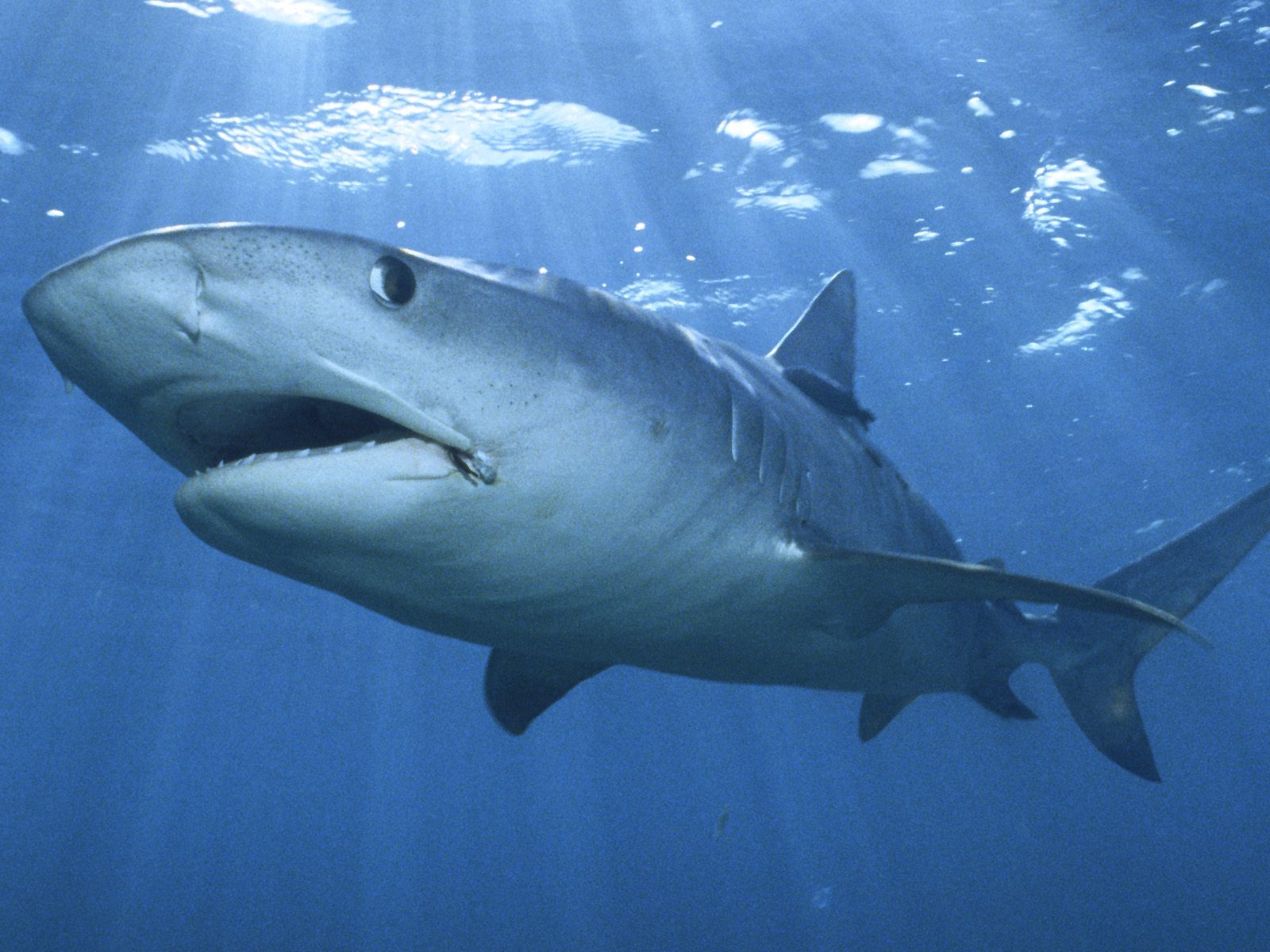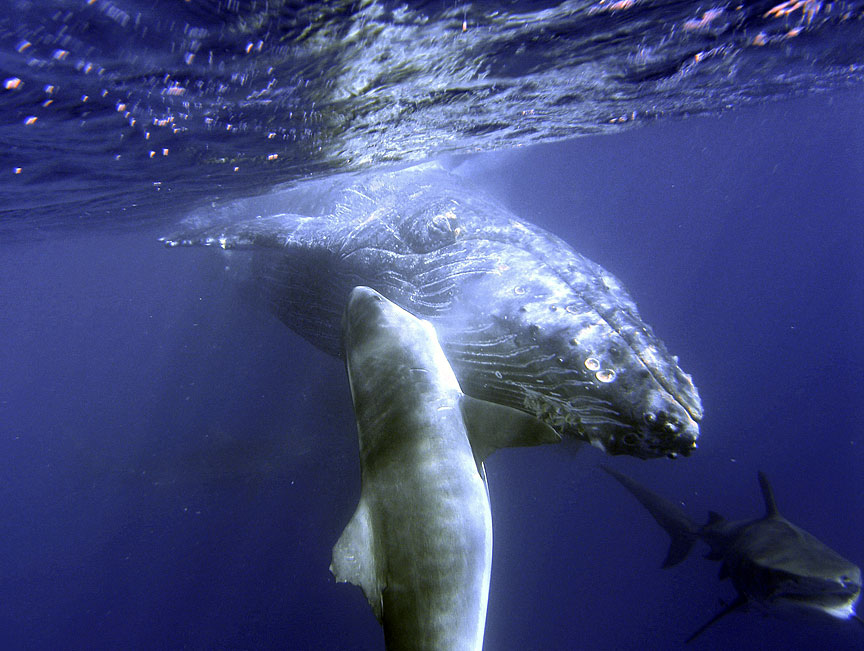Source(google.com.pk)
Tiger Sharks Diet Biography
As a group, sharks and batoids eat almost anything: fishes, crustaceans, mollus
cs, marine mammals, and other sharks.
2. While some sharks are probably not very selective feeders, certain sharks eat some foods more than others. For example, hammerhead sharks (Sphyrna spp.) are known for eating stingrays; bull sharks eat other sharks; and smooth dogfish (Mustelus spp.) eat crabs and lobsters.
3. Tiger sharks have been called "garbage cans of the sea" because they feed opportunistically on both live food and carrion. Prey includes bony fishes, other sharks, marine mammals, seabirds, and invertebrates. Tiger sharks are ecologically important predators of sea turtles and snakes.
4. Many sharks prey most often on the weak, inferior members of the population. They select the weak, ill, injured, or dying prey because it is easier to catch
Just about any animal in the ocean can be a meal to a shark. Great whites prey on California sea lions, wobbegongs eat shrimp, and tiger sharks feed on several species of sea turtles.
RETURN TO TOP
FOOD INTAKE
1. In a zoological environment, a shark eats about 1% to 10% of its total body weight per week. Studies on sharks in the wild show similar food intake. In other words, a 2.75 m (9 ft.) sand tiger shark weighing 131kg (289 lb.) may eat just 2 to 6 kg (4-13 lb.) a week.
RETURN TO TOP
METHODS OF COLLECTING AND EATING FOOD
1. The characteristic teeth of each species are adapted to the particular species' diet. The teeth may be serrated or smooth. Most are used for seizing prey, cutting, or crushing. For sharks, plate-like triangular teeth are the most common shape.
Each shark species has a unique tooth pattern.
2. Because of the biting force exerted by sharks (some up to 8,000 pounds per square inch) and the lack of a hard jaw bone to anchor the teeth in place, teeth often break off while sharks are feeding. They are replaced by teeth in reserve rows. The lemon shark (Negaprion brevirostris) can replace a tooth in about eight days.
3. Most predatory species of sharks seize, grasp, and tear food. A shark may circle its prospective prey and may even bump it with its snout or pectoral fins.
4. A shark's jaws are loosely connected to the rest of the skull at two points. As the upper jaw extends forward from the mouth, teeth of the lower jaw first encounter prey. The lower jaw teeth puncture and hold prey. The upper jaw teeth slice. A shark's short jaws make the bite powerful.
This lemon shark shows how it can extend its upper jaw allowing it to bite a wider area.










Tiger Sharks Diet Biography
As a group, sharks and batoids eat almost anything: fishes, crustaceans, mollus
cs, marine mammals, and other sharks.
2. While some sharks are probably not very selective feeders, certain sharks eat some foods more than others. For example, hammerhead sharks (Sphyrna spp.) are known for eating stingrays; bull sharks eat other sharks; and smooth dogfish (Mustelus spp.) eat crabs and lobsters.
3. Tiger sharks have been called "garbage cans of the sea" because they feed opportunistically on both live food and carrion. Prey includes bony fishes, other sharks, marine mammals, seabirds, and invertebrates. Tiger sharks are ecologically important predators of sea turtles and snakes.
4. Many sharks prey most often on the weak, inferior members of the population. They select the weak, ill, injured, or dying prey because it is easier to catch
Just about any animal in the ocean can be a meal to a shark. Great whites prey on California sea lions, wobbegongs eat shrimp, and tiger sharks feed on several species of sea turtles.
RETURN TO TOP
FOOD INTAKE
1. In a zoological environment, a shark eats about 1% to 10% of its total body weight per week. Studies on sharks in the wild show similar food intake. In other words, a 2.75 m (9 ft.) sand tiger shark weighing 131kg (289 lb.) may eat just 2 to 6 kg (4-13 lb.) a week.
RETURN TO TOP
METHODS OF COLLECTING AND EATING FOOD
1. The characteristic teeth of each species are adapted to the particular species' diet. The teeth may be serrated or smooth. Most are used for seizing prey, cutting, or crushing. For sharks, plate-like triangular teeth are the most common shape.
Each shark species has a unique tooth pattern.
2. Because of the biting force exerted by sharks (some up to 8,000 pounds per square inch) and the lack of a hard jaw bone to anchor the teeth in place, teeth often break off while sharks are feeding. They are replaced by teeth in reserve rows. The lemon shark (Negaprion brevirostris) can replace a tooth in about eight days.
3. Most predatory species of sharks seize, grasp, and tear food. A shark may circle its prospective prey and may even bump it with its snout or pectoral fins.
4. A shark's jaws are loosely connected to the rest of the skull at two points. As the upper jaw extends forward from the mouth, teeth of the lower jaw first encounter prey. The lower jaw teeth puncture and hold prey. The upper jaw teeth slice. A shark's short jaws make the bite powerful.
This lemon shark shows how it can extend its upper jaw allowing it to bite a wider area.
5. Many species of sharks and most rays are adapted for bottom feeding. Bottom feeders use the upper jaw to help pick up prey items. One example of a bottom feeder, the horn shark has two types of teeth. Front teeth are pointed for grasping and back teeth are flat and molar-like for crushing. Stingrays (family Dasyatidae) and eagle rays (family Myliobatidae) have teeth that are fused into plates.
6. Most sharks swallow their food whole, without chewing. Some sharks, however, like Port Jackson sharks (Heterodontus portusjacksoni) probably grind up food with their back flat teeth.
Port Jackson sharks have a combination of sharp and flat teeth. Their genus name is Heterodontus, meaning "different teeth".
7. Another mechanism some sharks and batoids use collecting food is filter feeding.
• Rays in the family Mobulidae (Manta spp., for example), the basking shark (Cetorhinus maximus), and the megamouth shark strain enormous quantities of plankton from the water on gill rakers. Up to a ton of food has been found in a basking shark's stomach.
• Whale sharks also filter feed, but instead of using gill rakers, they strain plankton through a spongy tissue supported by cartilaginous rods between the gill arches. Whale sharks can filter 1.5 million liters (400,000 gallons) of water per hour.
Although whale sharks have thousands of teeth in more than 300 rows, they no longer use them.
• Filter feeders have reduced, nonfunctional teeth.
• Gill rakers are composed of thousands of tiny teeth, which are periodically replaced as well. When the gill rakers are lost in the basking shark, some believe it will "hibernate" for months until the gill rakers grow back. It is theorized that a basking shark may go four or five months without eating as the gill rakers are replaced.
8. Some elasmobranchs are quite specialized for feeding.
• A thresher shark (Alopias spp.) uses the long upper lobe of its tail to corral schools of fish.
• A sawfish (Pristis pectinata) moves its head from side to side and strikes prey with its long rostrum. The sawfish has also been seen using the front of its snout to dig for prey buried under sand.
Sawfish swing their rostrums back and forth through schools of fish.
• Nurse sharks (family Ginglymostomatidae) use their thick lips to create suction, effectively pulling their prey from holes and crevices.
• A cookiecutter shark (Isistius spp.) uses suction to attach itself to whales and large fishes; it carves out a core of flesh with its large triangular teeth.
• Pygmy sharks (Euprotomicrus bispinatus) travel 1,500 m (4,920 ft.) up and down from the ocean floor every night to feed. This is equivalent to a human climbing 11 km (nearly seven miles) up and down each day to eat.
Tiger Sharks Diet
6. Most sharks swallow their food whole, without chewing. Some sharks, however, like Port Jackson sharks (Heterodontus portusjacksoni) probably grind up food with their back flat teeth.
Port Jackson sharks have a combination of sharp and flat teeth. Their genus name is Heterodontus, meaning "different teeth".
7. Another mechanism some sharks and batoids use collecting food is filter feeding.
• Rays in the family Mobulidae (Manta spp., for example), the basking shark (Cetorhinus maximus), and the megamouth shark strain enormous quantities of plankton from the water on gill rakers. Up to a ton of food has been found in a basking shark's stomach.
• Whale sharks also filter feed, but instead of using gill rakers, they strain plankton through a spongy tissue supported by cartilaginous rods between the gill arches. Whale sharks can filter 1.5 million liters (400,000 gallons) of water per hour.
Although whale sharks have thousands of teeth in more than 300 rows, they no longer use them.
• Filter feeders have reduced, nonfunctional teeth.
• Gill rakers are composed of thousands of tiny teeth, which are periodically replaced as well. When the gill rakers are lost in the basking shark, some believe it will "hibernate" for months until the gill rakers grow back. It is theorized that a basking shark may go four or five months without eating as the gill rakers are replaced.
8. Some elasmobranchs are quite specialized for feeding.
• A thresher shark (Alopias spp.) uses the long upper lobe of its tail to corral schools of fish.
• A sawfish (Pristis pectinata) moves its head from side to side and strikes prey with its long rostrum. The sawfish has also been seen using the front of its snout to dig for prey buried under sand.
Sawfish swing their rostrums back and forth through schools of fish.
• Nurse sharks (family Ginglymostomatidae) use their thick lips to create suction, effectively pulling their prey from holes and crevices.
• A cookiecutter shark (Isistius spp.) uses suction to attach itself to whales and large fishes; it carves out a core of flesh with its large triangular teeth.
• Pygmy sharks (Euprotomicrus bispinatus) travel 1,500 m (4,920 ft.) up and down from the ocean floor every night to feed. This is equivalent to a human climbing 11 km (nearly seven miles) up and down each day to eat.
Tiger Sharks Diet

Tiger Sharks Diet

Tiger Sharks Diet

Tiger Sharks Diet

Tiger Sharks Diet

Tiger Sharks Diet

Tiger Sharks Diet

Tiger Sharks Diet

Tiger Sharks Diet

Tiger Sharks Diet

Tiger Sharks Diet
No comments:
Post a Comment